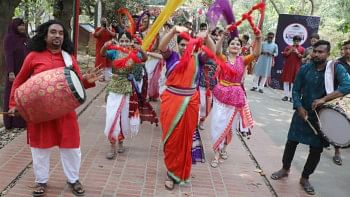Homestead forestry
In the backdrop of the predatory nature of deforestation, limitations of the public forestry activities, and abject rural poverty and livelihood insecurity, rural home gardens have assumed a special significance in recent times.
In the context of rural Bangladesh, homestead forestry or "home gardens" as they are more commonly called, connote an operational unit in which a number of crops including trees are grown with livestock, poultry and/or fish production, mainly for the purposes of satisfying the farmers' basic needs.
Rural home gardens, as one popularly cited source reveals, account for 48% of the total supply of saw and veneer logs, 70% of fuelwood, and 90% bamboo in Bangladesh. Despite the substantial contribution, however, research on homestead forestry is still in its nascent stage, and this promising sector of Bangladesh forestry has received very little attention from our policy planners.
In Bangladesh a typical homestead comprises of extended family houses, vegetable and horticultural gardens, trees, threshing grounds, livestock and poultry accommodation and rearing grounds, ponds and similar water reservoirs, bamboo, shrubs and bushes. Home gardens are located close to the houses and form a part of the intensively managed household management system.
The gardens are characterised by a mixture of annual or perennial species grown in association with each other. Although there are regional variations, homestead plantations typically exhibit a layered vertical structure of diversified economic value and domestic usage.
The upper stratum comprises of tree species. Horticultural species, including fruit trees and bamboo clumps, usually occupy the middle stratum. A range of vegetable species, such as bean, pumpkin, brinjal, chillies, etc accounts for the lower stratum. Besides, in many homesteads patipata is grown at the water level on the inner side of the pond bank. Several other species such as bhadi, mandar, and supari are grown along the boundary
Field studies show that, as compared to other components, fruit trees dominate in the home gardens. Farmers show a particular preference to fruit trees and assign the following reasons in support of their preference: (i) fruit trees provide immediate cash return; (ii) they substantially contribute to household food and nutrition requirements; (iii) they also support livestock; (iv) they can be used as "gift" items on socio-religious occasions and as a mark of hospitality to guests.
Farmers also plant timber tree species mainly to augment household income. Large households are especially interested in timber. Recent research suggests that the distribution of timber trees is significantly lower in landless and marginal households.
Among other things, poorer farmers reported that they felt discouraged to grow timber due to the threat of plundering by organised musclemen and loggers; the problem and cost of regular protection; the bureaucratic and procedural formalities and harassment in harvesting timbers (when they mature); financial hardship which does not allow the farmers to sustain through the long gestation period of, especially, the timbers of substantial economic value.
The proximity to natural forests and the availability of timbers in local markets also seem to influence the propensity to plant timber and fuelwood in home gardens. Farmers of landless and marginal households, however, grow higher percentage of fuel-wood as they are unable to access the local fuel-wood market owing to financial constraints. Likewise, non-timber forest products and vegetable gardens are also found in poorer households as compared to the relatively affluent households.
Farmers in rural Bangladesh typically follow a gender division of labour in managing the home gardens and the associated agro-forestry activities. Women play a most active and intensive role in the development and maintenance of the home gardens.
Drawing on a recent research, the benefits and preferred use of the homestead trees, as reported by respondent farmers, have been identified as follows (in order of farmers' preference): (i) Household wood and timber usage; (ii) Fruits as sources of food, nutrition and hospitality; (iii) Fodder and other livestock support roles; (iv) Fuel-wood usage; (v) Area demarcation and boundary lining purposes; (vi) Cash income generation; and (vii) Aesthetic purposes.
Home gardens are a part of the long heritage of traditional agro-forestry practices in Bangladesh as well as in other regions of Asia. Considering their great significance and contribution, increased research and attention on the rural home gardens seems to be the need of the time. The major potential areas of research include gender and equity issues, floristic and silvi-cultural characteristics, farmers' participation and preferences, policy and management aspects.
The salience and potential of homestead forestry as a means of enhanced food security and livelihood enhancement for rural farmers are yet to be fully appreciated and exploited in this country. This promising sector deserves immediate attention from our policy planners, academics, and development practitioners.

 For all latest news, follow The Daily Star's Google News channel.
For all latest news, follow The Daily Star's Google News channel. 



Comments